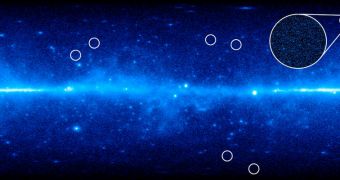In a new study funded by the US National Science Foundation (NSF), experts were able to place very strong limits on the mass range in which dark matter can exist. Details of the research effort were published in the December 1 issue of the esteemed scientific journal Physical Review Letters.
Knowing everything there is to know about dark matter is essential because the stuff is estimated to make up about 22 percent of the entire Universe. About 74 percent is accounted for by dark energy, with regular, baryonic matter accounting for just 4 percent.
As such, figuring out the basic properties of dark matter could make it easier for investigators to understand why the Cosmos arrived at its current configuration, how it did so, as well as the direction in which it's developing right now.
Dark matter is believed to interact with baryonic matter exclusively through the force of gravity, and to be made up of so-called Weakly Interacting Massive Particles (WIMP). The mass of WIMP has been a hotly-debated topic in the international scientific community for many years.
One of the most direct results of the new investigation is that reports produced by underground experiments – claiming to have detected dark matter – are inaccurate at best. The study indicates the stuff to have a mass greater than 40 gigaelectronvolts (GeV).
The research was led by Savvas Koushiappas, an assistant professor at the Brown University, and graduate student Alex Geringer-Sameth. They say that collisions involving heavy quarks must involve dark matter with a mass larger than 40 Gev.
Datasets the team used for this research were collected by the NASA Fermi Gamma-ray Space Telescope. They were augmented using statistical and computer models of dark matter particle mass.
“What we find is if a particle’s mass is less than 40 GeV, then it cannot be the dark matter particle,” Koushiappas explains of the most important conclusion in the new study. Underground experiments such as DAMA/LIBRA, CoGeNT and CRESST reported entirely different conclusions.
All of these installations claim to have found dark matter in the 7-12 GeV mass range, findings that are not supported by the Brown study data.
“If for the sake of argument a dark matter particle’s mass is less than 40 GeV, it means the amount of dark matter in the Universe today would be so much that the universe would not be expanding at the accelerated rate we observe,” Koushiappas concludes.

 14 DAY TRIAL //
14 DAY TRIAL //